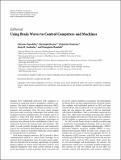Using Brain Waves to Control Computers and Machines
Author(s)
Papadelis, Christos; Braun, Christoph; Pantazis, Dimitrios; Soekadar, Surjo R.; Bamidis, Panagiotis
DownloadAHCI.2013.802063.pdf (427.9Kb)
PUBLISHER_CC
Publisher with Creative Commons License
Creative Commons Attribution
Terms of use
Metadata
Show full item recordAbstract
Humans have traditionally interacted with computers or machines by using their hands to manipulate computer components. This kind of human-computer interaction (HCI), however, considerably limits the human’s freedom to communicate with machines. Over the years, many attempts have been made to develop technologies that include other modalities used for communication, for example, speech or gestures, to make HCI more intuitive. Recent advances in cognitive neuroscience and neuroimaging technologies in particular have allowed for the establishment of direct communication between the human brain and machines. This ability is made possible through invasive and noninvasive sensors that can monitor physiological processes reflected in brain waves, which are translated online into control signals for external devices or machines.
Date issued
2013Department
McGovern Institute for Brain Research at MIT; Martinos Imaging Center (McGovern Institute for Brain Research at MIT)Journal
Advances in Human-Computer Interaction
Publisher
Hindawi Publishing Corporation
Citation
Papadelis, Christos, Christoph Braun, Dimitrios Pantazis, Surjo R. Soekadar, and Panagiotis Bamidis. “Using Brain Waves to Control Computers and Machines.” Advances in Human-Computer Interaction 2013 (2013): 1–2.
Version: Final published version
ISSN
1687-5893
1687-5907